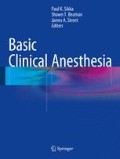Abstract
Critical care medicine is a multidisciplinary healthcare specialty that cares for patients with acute, life-threatening illness or injury. Many disease processes lead to critical illness, and these disease processes are commonly treated in an intensive care environment. Critically ill patients may be ill either due to medical or surgical causes, but the treatment of the illness is more or less the same. Table 40.1 lists the seven Cs of critical care.
Access this chapter
Tax calculation will be finalised at checkout
Purchases are for personal use only
Further Reading
Bellomo R, Kellum JA, Ronco C. Defining and classifying acute renal failure: from advocacy to consensus and validation of the RIFLE criteria. Intensive Care Med. 2007;33:409–13.
Bone RC, Balk RA, Cerra FEB, et al. Definitions for sepsis and organ failure and guidelines for the use for innovative therapies in sepsis. The ACCP/SCCM Consensus Conference Committee. American College of Chest Physicians/Society of Critical Care Medicine. Chest. 1992;101:1644–55.
Dellinger RP, Levy MM, Carlet JM, et al. Surviving sepsis campaign: international guidelines for management of severe sepsis and septic shock. Crit Care Med. 2008;36:296–327.
Finfer S, Bellomo R, Boyce N, et al. A comparison of albumin and saline for fluid resuscitation in the intensive care unit. N Engl J Med. 2004;350:2247–56.
Gabrielli A, O’Connor MF, Maccioli GA. Anesthesia advanced circulatory life support. Retrieved on 14 April 2008 from http://www.asahq.org/clinical/Anesthesiology-CentricACLS.pdf
Hickey RW, Billi JE, Nadkarni VM, et al. 2005 American Heart Association guidelines for cardiopulmonary resuscitation and emergency cardiovascular care. Circulation. 2005;112(24). IV-1–IV-84.
International Liaison Committee on Resuscitation. 2005 International consensus on cardiopulmonary resuscitation and emergency cardiovascular care science with treatment recommendations. Circulation. 2005;1112:III-1–III136
Johnston C. Endotracheal drug delivery. Pediatr Emerg Care. 1992; 8:94–7.
MacIntyre NR. Respiratory mechanics in the patient who is weaning from the ventilator. Respir Care. 2005;50(2):275–86.
Marshall JC, Cook DJ, Christou NV, et al. Multiple organ dysfunction score: a reliable descriptor of a complex clinical outcome. Crit Care Med. 1995;23:1638–52.
Meade M, Guyatt G, Cook D, et al. Predicting success in weaning from mechanical ventilation. Chest. 2001;120(6 Suppl):400S.
Pandharipande PP, Pun BT, Herr DL, et al. Effect of sedation with dexmedetomidine vs lorazepam on acute brain dysfunction in mechanically ventilated patients: the MENDS randomized controlled trial. JAMA. 2007;298(22):2644–53.
Rivers E, Nguyen B, Havstad S, et al. Early goal-directed therapy in the treatment of severe sepsis and septic shock. N Engl J Med. 2001;345:1368–77.
Russell JA, Walley KR, Singer J, et al. Vasopressin versus norepinephrine infusion in patients with septic shock. N Engl J Med. 2008;358:877–87.
Saito M, Terao Y, Fukusaki M, et al. Sequential use of midazolam and propofol for long-term sedation in mechanically ventilated patients. Anesth Analg. 2003;96:834–8.
Weaver LK, Hopkins RO, Chan KJ, et al. Hyperbaric oxygen for acute carbon monoxide poisoning. NEJM. 2002;347(14):1057–67.
Author information
Authors and Affiliations
Corresponding author
Editor information
Editors and Affiliations
Clinical Review
Clinical Review
-
1.
Shock in sepsis is of the following type
-
A.
Cardiogenic
-
B.
Vasodilatory
-
C.
Toxic
-
D.
Hypovolemic
-
A.
-
2.
Nitric oxide is a pulmonary
-
A.
Vasoconstrictor
-
B.
Vasodilator
-
C.
Neither A nor B
-
D.
Artery pressure autoregulator
-
A.
-
3.
All of the following are end points in resuscitation of shock, except
-
A.
Systolic blood pressure of >90 mmHg
-
B.
Mean arterial pressure of >65 mmHg
-
C.
Urine output of >0.5 ml/kg/min
-
D.
Lactate of <6 mmol/L
-
A.
-
4.
Preferred type of ventilation in a patient with ARDS would be
-
A.
Intermittent mandatory
-
B.
Pressure support
-
C.
Airway pressure release
-
D.
PEEP
-
A.
-
5.
Administration of oxygen to neonates may most likely cause
-
A.
Retinal hemorrhage
-
B.
Corneal detachment
-
C.
Myopia
-
D.
Retinopathy
-
A.
-
6.
ARDS is characterized by
-
A.
Increased capillary permeability
-
B.
Increased capillary hydrostatic pressure
-
C.
Increased surfactant concentration
-
D.
PaO2/FiO2 ratio <400
-
A.
-
7.
A patient with atrial fibrillation, with HR 160/min and BP 84/54 mmHg, is treated with
-
A.
Esmolol
-
B.
Diltiazem
-
C.
Lidocaine
-
D.
Cardioversion
-
A.
-
8.
Gradual lengthening of the PR interval followed by a dropped beat is characteristic of
-
A.
1st-degree AV block
-
B.
2nd-degree type I AV block
-
C.
2nd-degree type II AV block
-
D.
3rd-degree AV block
-
A.
Answers: 1. B, 2. B, 3. D, 4. C, 5. D, 6. A, 7. D, 8. B
Rights and permissions
Copyright information
© 2015 Springer Science+Business Media New York
About this chapter
Cite this chapter
Sikka, P.K. (2015). Critical Care. In: Sikka, P., Beaman, S., Street, J. (eds) Basic Clinical Anesthesia. Springer, New York, NY. https://doi.org/10.1007/978-1-4939-1737-2_40
Download citation
DOI: https://doi.org/10.1007/978-1-4939-1737-2_40
Publisher Name: Springer, New York, NY
Print ISBN: 978-1-4939-1736-5
Online ISBN: 978-1-4939-1737-2
eBook Packages: MedicineMedicine (R0)

